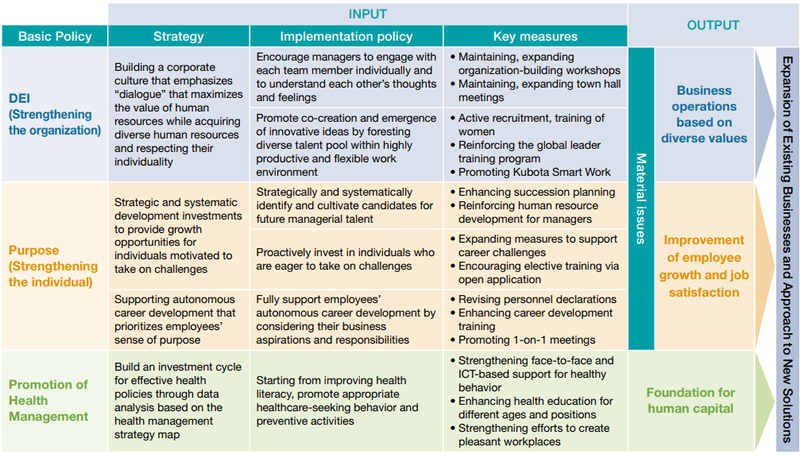Personnel Policies and HR System (Kubota Corporation)
Amid worldwide calls to ensure that each individual’s values and ideas are respected in the workplace, Kubota is engaged in a global initiative to create a workplace environment that benefits from diversity and offers a sense of security. In its deployment of human resources, Kubota will continue to take due account of workplace safety and contributing to employee health so as to create safe and vibrant environments, which will in turn help to build a sustainable society.
Policy background
- In order for the Company to realize GMB2030, it is essential to expand existing businesses. In parallel, we need to provide solutions to social issues through collaboration among the three fields of food, water, and the environment.
- Since its establishment, the Company has been seeking human resources who can take on challenges for the development of society, and has been operating its business based on the important values of “On-Site Needs First Policy” and “On Your Side Spirit.” In order to expand existing businesses and develop new solution businesses, the Company continues to respect these values while focusing on the following three concepts that are necessary to embed in the Company as basic policies: 1. Diversity, Equity, and Inclusion (DEI); 2. Purpose; 3.Promotion of Health Management.
Basic Policy
- DEI (Strengthening the organization): New value is created by bringing together and connecting diverse human resources, which in turn becomes a source of innovation and sustainability. The Company believes that building a corporate culture that emphasizes “dialogue” and drawing out individual abilities is the key to achieving DEI. The realization thereof will lead to the materiality, “Business operations based on diverse values.”
- Purpose (Strengthening the individual): Each individual must take on the challenge of resolving issues in uncharted areas, and to do so, each individual must have a strong “Purpose” and demonstrate his or her individual strengths. This leads to the materiality, “Improvement of employee growth and job satisfaction.”
- Promotion of Health Management: In order for the Company to continue to create solutions needed by society, the physical and mental health of employees, who are the driving force of the Company’s operations, is essential. By creating workplaces in which each individual can achieve a real sense of job satisfaction and fulfillment founded on mental and physical health, we aim to maximize the performance of our organization and thereby underpin the Kubota human capital strategy.
Value Creation Process for Human Capital
The driving force to solve environmental and social issues through expansion of existing businesses and new solutions in the future will be a “strong and flexible organization” and “diverse and autonomous human resources,” and reinforcing them is crucial.
Moving forward with personnel measures grounded in our basic approach to human capital will feed into the resolution of our areas of materiality, and accelerate our expansion of existing businesses and efforts to develop new solutions.
For further information on Human Capital Strategy, please refer to the Kubota Group Integrated Report
HR System
Foster a corporate culture full of vigor with emphasis on taking on challenges and creativity.
Find the right person for the right job based on their abilities and ambitions.
- Basic idea of personnel system operations
-
- Equal opportunity Each employee can strive to attain any role or position.
- Right person for the right job Aim to place the right person in the right job based on their abilities and ambitions
Overview of Personnel Training, Performance-based Promotion and Compensation
There are three career paths comprising expert positions, staff positions and technical positions for different roles and responsibilities. The personnel system offers personnel training, and performance-based promotion and compensation for each of these career paths.
Employees can change career paths based on their abilities and ambitions.
| Career | Expert positions (management class) |
Staff positions |
Technical positions |
|---|---|---|---|
| Definition of personnel(main roles) |
People who drive the business, solve problems that arise in operations, and exhibit a high level of performance based on their willingness to take on challenges, advanced expertise, abundant knowledge and extensive experience and know-how |
People who contribute to the business, take on challenges for their own growth, and take on broad responsibilities, especially work that requires expertise, creativity and experience, while aiming to establish a field of expertise |
|
| Training and education |
|
||
|
|
||
|
|
||
| Evaluations |
|
|
|
| Rotation | The work responsibilities of each employee are reviewed periodically, taking into consideration workplace needs and the employee’s preferences, to avoid having employees perform the same work for long periods. | - | |
| Ranking(Basis upon which compensation is determined) |
|
|
|
| Salaries | Monthly salaries are set based on ranking and evaluation. | ||
| Bonuses | Bonuses are designed to reflect consolidated performance and individual performance. | Bonuses are designed to reflect individual performance and bonus amounts set as standards in annual labor-management negotiations. | |
| Retirement benefits |
Retirement benefits are based on a point system that reflects rank, years of service, and evaluation. |
||
